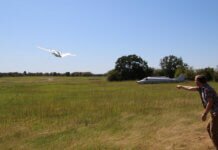 Unmanned aircraft system researchers associated with the Mid-Atlantic Aviation Partnership (MAAP) of Virginia Tech and Rutgers University recently tested new technology designed to prevent collisions with other aircraft.
Unmanned aircraft system researchers associated with the Mid-Atlantic Aviation Partnership (MAAP) of Virginia Tech and Rutgers University recently tested new technology designed to prevent collisions with other aircraft.
The flights from Cape May County Airport in New Jersey involved a fixed-wing aircraft that stayed within sight of ground observers. The effort represents the partnership’s first flights in New Jersey, says Virginia Tech.
“The development of sense-and-avoidance technology is a critical path toward the safe introduction of unmanned aircraft systems into the nation’s airspace,” says David Yoel, CEO of American Aerospace Technologies Inc., a Pennsylvania-based company that provided and piloted the test vehicle. “The aircraft was equipped with sensing equipment that allowed it to monitor its position in the airspace.”
The UAS, an RS-20 with a wingspan of more than 17 feet, is controlled by a pilot on the ground in a central command center that maintains communication with the aircraft at all times.
Ultimately, Virginia Tech explains, the Federal Aviation Administration (FAA) will decide whether unmanned aircraft activities for these types of operations have met safety standards.
“With this mission, we are expanding our research from isolated rural areas with very little air traffic to a small, public airport on the Atlantic coast,” comments Rose Mooney, executive director of MAAP.
Cape May County Airport is a general aviation airport about four miles north of Wildwood, N.J., and logs about 39,000 airplane and helicopter takeoffs each year. The airport is owned by Cape May County and operated by the Delaware River and Bay Authority, a bistate governmental agency.
Virginia Tech is home to one of the six FAA-designated test sites for UAS. Operating under the banner of MAAP, with academic partners Virginia Tech, Rutgers University and the University of Maryland, the program includes test sites in Virginia, New Jersey and Maryland and more than 100 industry partners.









